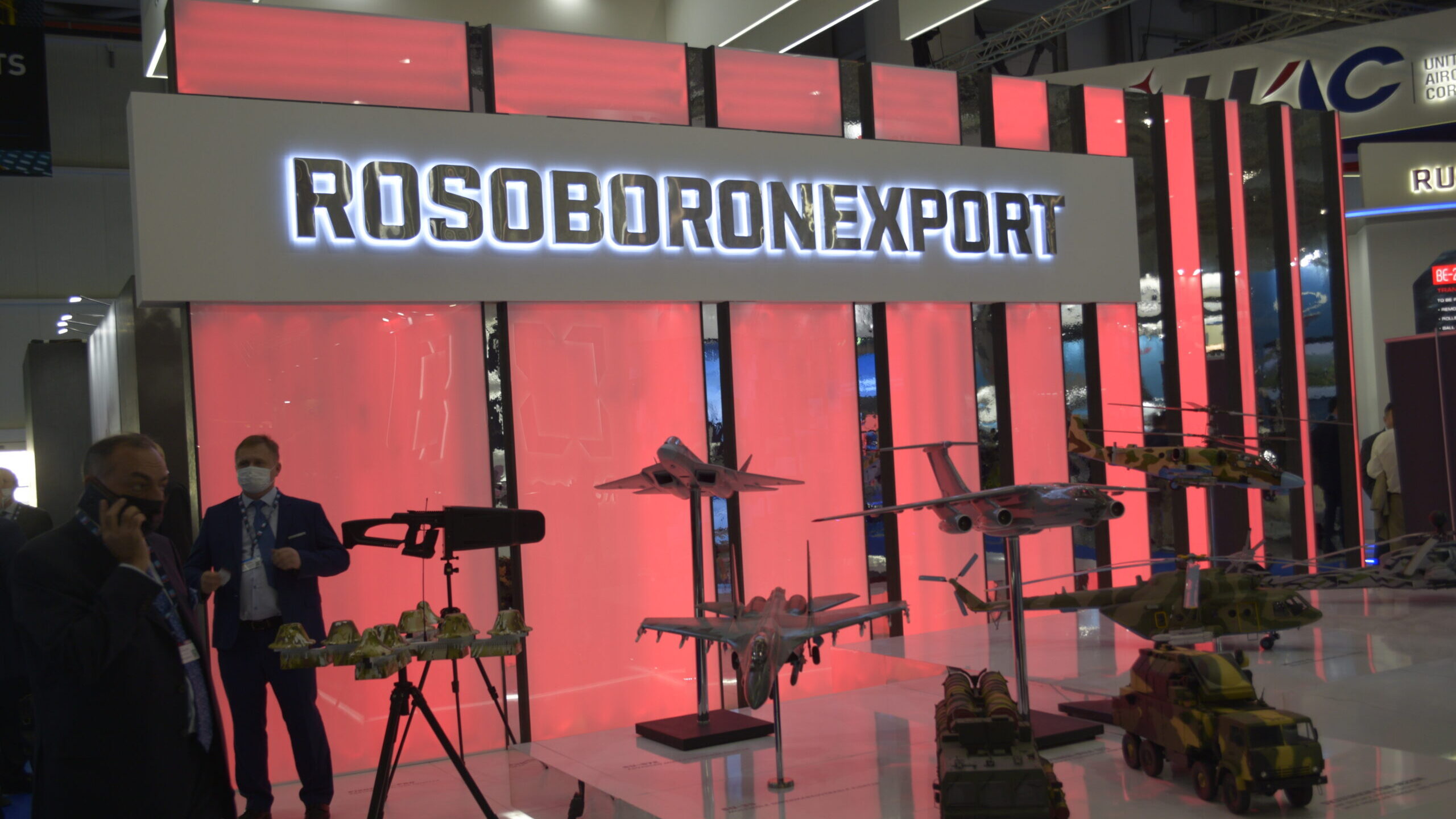
Rosoboronexport, a state organization for the import and export of defense technology, shows models at the Dubai Airshow. (Photo: Reuben Johnson/Breaking Defense)
KYIV: Attendees at this year’s Dubai Airshow walked away from the event with two big takeaways. The first: simply that the event, the first major airshow since the onset of the COVID-19 pandemic, actually happened. The second: that Russia, sensing doubts about America’s commitment to the region, is making a serious push into the Middle Eastern market.
Russia’s presence surpassed the size of Moscow’s delegation at any previous Dubai events by several orders of magnitude. Almost 500 people were present representing a long list of defence enterprises. Russian firms ordered and paid for more than 1,000 square metres of space in the exhibition halls, five two-story chalets and a small fortune of support services in the form of golf carts and VIP parking passes.
Still, despite the spending spree, the show passed without Russian industry announcing any significant contract signings or sales agreements. Which raises the question of why the major entities on the Russian side — Rostec, the Unified Aircraft-Building Corporation (OAK) and Rosoboronexport — invested so much in participating in the event.
Part of the answer lies in the one Item from Russian industry that dwarfed almost every other aircraft on display: the cavernous pavilion constructed on the static display line that housed the full-scale, part-prototype/part mock-up of the new Sukhoi Su-75 Checkmate single-engine lightweight fighter
The ten-minute presentation of the aircraft, making its international debut, featured a laser light show, multiple flat panel screens and a mirrored ceiling — all first seen in July of this year, at the initial unveiling of this design at the Moscow Aviation and Space Salon (MAKS). These multimedia spectacles were space-limited, and in such demand to be seen by senior officials from the United Arab Emirates and others that for two days gaining access to the pavilion was essentially impossible.
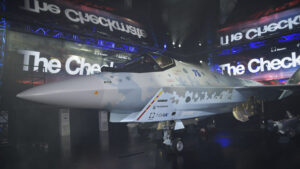
A Russian Checkmate fighter on display at the Dubai Airshow. (Photo: Reuben Johnson/Breaking Defense)
It quickly became the most talked-about item of the entire show. This was despite the fact, that, as one former official from Russia’s famed Mikoyan Design Bureau told Breaking Defense, “the engine for the aircraft does not exist, the AFAR (AESA radar) does not exist, the airplane has not yet taken to the air as no flyable prototype exists, and the majority of the on-board, next-generation avionics are still only designs at this point. And discussions about a first flight as soon as 2023 are simply not to be taken seriously.”
When speaking with members of the Russian delegation, it is clear that they feel a long-term strategy is underway: one that Moscow hopes will re-draw the map of arms sales in the Middle East and other regions.
Whether this substantial menu of Russian ambitions can be achieved remains to be seen. “If Russian industry can attract this new customer base is one issue,” said the head of a Russian defence consultancy with close ties to Rostec and major enterprises. “However, there is still plenty that can go amiss. Should the Kremlin make any rash moves — like invading Ukraine — and all of these planning and the investment made in trying to enter this market will be for nothing.”
Development and Procurement Plans
On the first day of the Dubai show ,the General Director of OAK, Yuri Slyusar, announced “the plant in Komsomolsk-on-Amur will begin work on the construction of several Checkmates at the same time.” The building of these prototypes in parallel rather than in series, one after the other, demonstrates that the program has the highest priority, as this is a more resource-intensive method of developing flight test platforms, siphoning off personnel and facilities at the plant that could be utilized by other efforts.
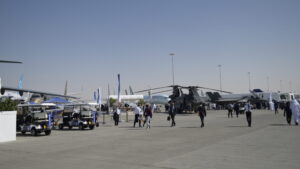
Aircraft on display at the Dubai Airshow. (Photo: Reuben Johnson/Breaking Defense)
The Checkmate prototypes will be powered with a single previous-generation Satutn/Lyulka AL-41F1 engine, the same model that is currently installed in Russia’s other stealth-like fighter design, the twin-engine Su-57. Both aircraft are planned to eventually be powered by a new fifth-generation fighter engine, designated at the moment as izdeliye 30 and in development at the UPMO plant in Ufa; but as recently as last month, Russian news sources reported that this engine is still not developed to the stage where it could enter series production.
Until this new design is available, both the Su-57 and the Checkmate (whenever a flyable unit has been built) will be powered by this AL-41F1-series engine (originally introduced as Engine 117S) that has been in service for more than a decade as the power plant for the Su-35S. This follows a Russian pattern that stretches back into the 1980s of utilizing an older-generation engine in initial batches of new design fighters until the engine model ultimately designed for the aircraft is available.
Aside from the lack of engine and flyable design, Checkmate also has to overcome the fact is it not yet a program of record. When it was first introduced in July Slyusar and the other senior industry representatives present stated that there was no interest by Russian Aerospace Forces (VKS) in acquiring this platform, which could dampen the enthusiasm of any potential export customers.
However, in September Russian Deputy PM and former Deputy Defence Minister for Procurement, Yuri Borisov, stated that the aircraft could be procured by the VKS as part of the Russian State Armaments Programme for the period 2024-2033. Borisov, realizing the need for a domestic customer in order to be able to sell the aircraft outside of Russia reportedly told the Russian press that “the presence of a new fighter in service with its own army will contribute to the export potential of the aircraft.”
An F-35 Alternative – At Least On Paper
The history of the Checkmate begins in early 2017 at the Abu Dhabi IDEX expo when Rostec General Director Sergei Chemezov offered the UAE the opportunity to participate in the development of the aircraft. After a series of negotiations, the UAE was poised to sign an interim agreement to cooperate on this effort, but the deal was derailed in November of the same year when Washington it would finally allow the UAE to buy its long-sought Lockheed Martin-designed F-35.
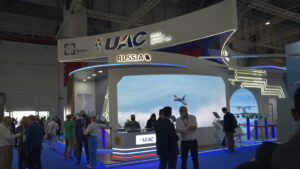
Russia’s United Aircraft Corporation was represented at the Dubai Airshow. (Photo: Reuben Johnson/Breaking Defense)
That decision appeared to snuff out any interest by the UAE in becoming a major defense industrial partner with Russia. But in the intervening time, the F-35 deal has bogged down due to concerns over the UAE’s relationship with Beijing.
The first sticking point has to do with what the US sees as Abu Dhabi’s increasing military partnership with the PRC. Beijing has been shipping a considerable volume of defense equipment to the UAE, creating a concern from US officials that the Chinese are planning to establish a base in the Emirates.
Construction on what appeared to be a secret Chinese facility inside the container terminal at the UAE port of Khalifa raised red flags in DC. At the end of September, the US National Security Advisor, Jake Sullivan, and the Biden Administration’s Middle East coordinator, Brett McGurk, visited the UAE and presented the Emirati leadership with intelligence information on the site. After a US inspection of the terminal, all construction work on the Chinese project was suspended.
While that problem has been solved, at least for now, a more serious point of contention presents a new obstacle in the form of the PRC telecom firm Huawei. Due to security concerns about the stealthy aircraft’s design details being compromised, the US is telling it must now remove all the Huawei 5G equipment in its networks in order to stay on board as an F-35 customer.
(There is precedent for this step, dramatic as it may seem. The UK, one of the F-35s major partners, has previously agreed that no new Huawei hardware would be purchased for its networks after the end of this year. All existing Huawei equipment in the UK will be removed by 2027.)
This series of restrictions and the demands by the US are seen by Moscow as an opportunity to again offer the Checkmate project to the UAE as a “no strings attached” alternative to the F-35.
But several of the Russian industry representatives pointed out to Breaking Defense that while nothing would make them happier than to see the UAE “switch horses” by becoming a partner on the Checkmate project and forgoing purchase of the F-35, this may not be the top priority for Chemezov, Slyusar and the other industry leaders.
Russian defense firms are interested in a much broader footprint in the Middle East market and beyond. And while the deep pockets of the Emiratis are seen as essential to helping Russia move design concepts from prototype validation to series-production, industrial leaders are eyeing potential customers beyond the UAE’s borders.
In March 2022, Saudi Arabia will hold one of the largest-ever expos of its kind, and Russian industry plans to have a presence of equal or greater size than was presented at Dubai. This is part of a two-pronged initiative designed to have Moscow capture some of the business from the Gulf States that had been the exclusive territory of the US and European suppliers.
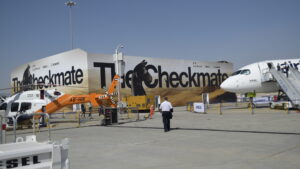
An advertisement for the Russian Checkmate fighter. (Photo: Reuben Johnson/Breaking Defense)
“There is a reason that Saudi Arabia is such a major export target now for Russian weapon systems in general and the Checkmate in particular,” explained the former Mikoyan representative. “Unlike the UAE, Saudi Arabia are probably not going to be offered the F-35. They also have ambitions to have their own aerospace production capability across a range of different systems, which makes something like Checkmate — a system they could build for their own armed forces as well as export to other nations — an attractive option”
New Partnerships May Close Iranian Doors
If Russia is now looking to Riyadh and Abu Dhabi as its regional partners, it may mean closing the book on Moscow’s more than three decades-long aspirations to become the supplier of an entire new generation of weaponry to Iran.
Due to centuries-old traditional religious conflicts and modern-day hostilities between the Sunni Islam Arabs of the Gulf states and the Persian Shiites in Iran, being the quartermaster to both sides is a non-starter. But the change in loyalty hasn’t come out of nowhere.
Moscow’s intentions were more or less telegraphed three years ago at the 2018 Iran Air Show, held just a short distance from Dubai on Kish Island. Russian firms, which had been major exhibitors at the previous event in 2016, where nowhere to be found.
One Iranian firm responsible for maintaining and modernizing Russian-made aircraft operated by the Iran Revolutionary Guard Corps (IRGC) has previously told Breaking Defense that “when we ring to Moscow and tell them we are calling from our Iranian company they do not bother to even ask what we want – they just hang up on us.”
Other Russian firms, like RSK-MiG, have had no formal contract links with Iran for some years. Officials from these companies tell Breaking Defense that Iranian firms have instead turned to sourcing spares and other needed hardware for Russian aircraft through networks of under-the-table suppliers – similar to those middlemen they have used for decades to illegally acquire hardware for their fleets of US-made McDonnell-Douglas F-4s and Grumman F-14s.
If Russia does move away from Tehran, expect China to try and fill the void. Chinese specialists have been in Iran for decades, assisting local industry in the art of reverse-engineering parts for their US-made weapon systems. One of the PRC’s major defense industrial groupings, China Electronics Technology Corporation (CETC) was an exhibitor at the 2016 Iran Air Show.
Then in July 2018 the IRGC upgraded its fleet of Russian-made Sukhoi Su-22 attack aircraft, which had been grounded for almost three decades, by replacing their on-board systems with largely PRC-origin avionics. The fleet was also integrated with an entire complement of Chinese air-launched weapons to the air frame; video of the acceptance ceremony showed a large, air-dropped munition that appeared to the NORINCO TG-250, a Chinese system similar to the US-made GBU-12 Paveway II.
There will be plenty of opportunity for China to push future sales. Tehran’s 1970s-era F-4s, F-5s and F-14s have very little service life left in them. Once they must be retired, Iran may become the first export customer for one of the Chinese copies of the Russian Su-27 and Su-30 models – the Shenyang J-11 and J-16 series. Another option is even Iran acquiring the Chengdu J-20, the PRC’s attempt to pose a challenge to the current-day US F-22.






















